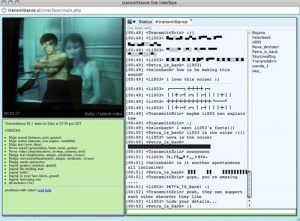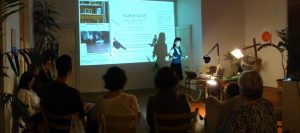I really do wonder what the Tate Modern means when they say that their “live performance room” is “the only place you can see art made for you to view at home“. Quite aside from the myriad artworks available online for people to experience – live or otherwise – have they forgotten about television, radio, and other media, digital and analogue, that has made the viewing of art possible not only at home but in all kinds of private and domestic spaces for – well, a very long time?
Instead of expressing my frustration the Tate staff’s ignorance of the field they claim to lead (they describe their Live Performance Room series as “ground-breaking” and “the first artistic programme created purely for live web broadcast”), I’m going to talk about some of the other, actually ground-breaking and innovative work that you can not only view, but also participate in, from the comfort of your own home; which is actually nothing new – ground-breaking artists have been creating this kind of work for at least 15 years.

Last Saturday night, while sitting at home, I had the pleasure of participating in “Transmittance“, an ongoing networked performance project by Maja Delak & Luka Prinčič – this time in collaboration with artists at the Trouble festival in Brussels. “Transmittance” combines a live audio-visual stream with an IRC chat, and invites online participants to guide the action by selecting from a range of “choices” – movements, sound, text – that are then performed by the artists to the camera.
From the online participants’ perspective, as well as the abilities and energy of the performers and the technical wizardry of the accompanying visuals and audio, two very important roles are the moderator and the camera person. These people anchor us, the online participants, into the work. Camera operator Samuel Volson carefully framed our view of the space – three interconnecting rooms, with wooden floors and nice doors – sometimes giving us a glimpse the hub of computers from which everything was controlled but mostly showing the performance room and projection. TransmittErin was our moderator, passing our requests on to the performers, reminding us which choice we had made, encouraging us or giving us time checks, and joining in with our banter. We, the online participants, formed quick relationships based on witty repartee, imaginative use of text and fonts, and playful competitiveness and collaboration. We had a lot of fun; we questioned the work, at the same time as guiding it; we participated at the same time as being spectators. It felt very inclusive (especially the numerous spontaneous “all inclusives” as the performers jumped in to each other’s actions to support them).
A couple of weeks ago I was in Nantes for Electropixel, where I presented UpStage, an online platform through which people have been viewing art at home for eight years now. This time I was not performing, but introducing two performances from past festivals: “Flat Earth” from last year, and “Veni! Ελθέ! Dodji! to the Zapata Private/Pirate Birthday Party. And, Vice Versa …” from 2008. Both of these shows are being remounted for the retrospective section of the 121212 UpStage Festival of Cyberformance in December. On this occasion, as well as the online audience there were simultaneous screenings of the two shows at Electropixel and at Odin Teatret in Denmark. The artists were located in Serbia, the Netherlands and Denmark. Neither of these shows incorporates audience interaction to the same extent as “Transmittance”, but as with all UpStage shows the online audience can and do interact via the text chat, providing a unique accompaniment to each live performance.
The weekend before Electropixel I was in Berlin, from where I delivered my half of the networked performance “make-shift“; this is art that is not only made to view at home, it is made FROM homes, as my collaborator Paula Crutchlow and I are located (separately) in ordinary domestic living rooms for the live performance. A small group of participants in each house co-author the performance with us for the online audience – who in turn contribute to the event. We use a purpose-built interface that combines UpStage with audio-visual streams. Paula and i multitask like crazy, with the help of all the participants, to create a discursive collage of ideas, images and activities.
 There has been a host of other artistic activities happening in environments from Second Life to Chat Roulette the Tap, which have all been made for you to “view at home” (or wherever you happen to access the internet). Some are more interesting than others, but all are experimenting with the internet as a place to create live art for online audiences. Many of them, such as “Transmittance” and “make-shift”, are exploring new relationships between artist and spectator/participant, creating discursive spaces and actively questioning what it means to make live art on the internet. This is in stark contrast the Tate’s comparatively tame project, where the online audience are treated like a TV audience, the artists’ comments suggest that they haven’t actually given much thought to the online audience, and the chat interface doesn’t facilitate lively discussion between those online.
There has been a host of other artistic activities happening in environments from Second Life to Chat Roulette the Tap, which have all been made for you to “view at home” (or wherever you happen to access the internet). Some are more interesting than others, but all are experimenting with the internet as a place to create live art for online audiences. Many of them, such as “Transmittance” and “make-shift”, are exploring new relationships between artist and spectator/participant, creating discursive spaces and actively questioning what it means to make live art on the internet. This is in stark contrast the Tate’s comparatively tame project, where the online audience are treated like a TV audience, the artists’ comments suggest that they haven’t actually given much thought to the online audience, and the chat interface doesn’t facilitate lively discussion between those online.
But, never mind the Tate; they should know better, of course, as they hold documentation of innovative online work from the past (for example in the ICA archives) and have people within the organisation who have worked in the field. However the really interesting stuff continues regardless, and perhaps we’ll benefit from more mainstream audiences being exposed to the idea of cyberformance and actively seeking out more experimental work. If your interest has been piqued, please check out the CyPosium (cyberformance symposium) that is taking place on 12 October, with presentations and discussions about cyberformance (live online performance) over the last couple of decades.
Reinventing the wheel
Comment submitted by Garrett Lynch on 12 June 2012 – 9:51pm.
Your not alone in your frustration Helen. I’ve been following the Tate performances since the second performance and documenting them, it’s clear they suddenly put on a big publicity drive from the second performance onwards as the first seemed to go unnoticed. I was enthusiastic about the second performance as the artist did ‘play’ to the idea of spectatorship though the lens quite well but certainly not in a way new or unique – as you said we have seen it before, 15 years is a modest (web specific) estimate. My frustration grew after the third performance which seemed to have little or no relation to the online ‘site’. I’m willing to overlook claims of having ‘reinvented the wheel’ if subsequent performances are indeed site-specific. Without this the premise of these performances seems completely pointless. If these are really just new artists who the Tate feel are leading the way in performance then why add this whole online aspect, who do they think it will pull in, the later day net.artists? Seeing ideas which have been done before isn’t necessarily a bad thing as each artist will have a different take (it’s the optimistic side of me saying this) and to be honest I do expect to see at the Tate things I will have seen before and probably better at independent galleries, alternative venues or events. These have to trickle up to the institution. However I do wonder how the artists have been chosen for this series of performances. So far none have had a history of working with any form of networked, broadcast or multi-site performance.